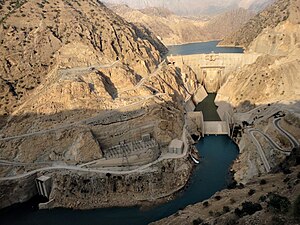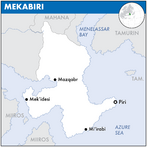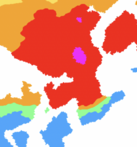Mekabiri: Difference between revisions
m (→Politics: added ziggurat building and references) |
No edit summary |
||
| Line 42: | Line 42: | ||
|languages2 =<!--Languages of this second further type--> | |languages2 =<!--Languages of this second further type--> | ||
|languages2_sub =<!--Is the second alternative type of languages a sub-item of the previous non-sub type? ("yes" or "no")--> | |languages2_sub =<!--Is the second alternative type of languages a sub-item of the previous non-sub type? ("yes" or "no")--> | ||
|ethnic_groups =<!--List/breakdown of ethnic groups within the country/territory--> | |ethnic_groups = Nakhainean, Lorainean, Alainean, Veinainean, Kurdokainean, Arakhainean <!--List/breakdown of ethnic groups within the country/territory--> | ||
|ethnic_groups_year =<!--Year of ethnic groups data (if provided)--> | |ethnic_groups_year =<!--Year of ethnic groups data (if provided)--> | ||
|ethnic_groups_ref =<!--(for any ref/s to associate with ethnic groups data)--> | |ethnic_groups_ref =<!--(for any ref/s to associate with ethnic groups data)--> | ||
|religion = | |religion = Juluvanism | ||
|religion_year =<!--Year of religion data (if provided)--> | |religion_year =<!--Year of religion data (if provided)--> | ||
|religion_ref =<!--(for any ref/s to associate with religion data)--> | |religion_ref =<!--(for any ref/s to associate with religion data)--> | ||
| Line 138: | Line 138: | ||
The name of Mekabiri is an {{wp|exonym}}, originating as the [[Oharic]] word ''Mek’abiri'' (መቃብር, "grave"). This name is a reference to the relative position of where the Sun sets or "goes to die" when viewed from [[Orioni]]. During the [[#Colonial period|colonial period]] (1349-1822) the country was called [[#Colonial period|Birlini]]. Other names have also been used, for example ''Mi'irabi'' ("west"), a term which applies to both Mekabiri and neighbouring [[Miiros]]. The frequent misspelling ''Merikebi'' ("ship" or "vessel") is a reference to the many ships that once sailed back and forth between Mekabiri and Orioni. Late [[Aroma]]n historical sources have come to associate Mekabiri's hot and unforgiving climate with the ''{{wp|macabre}}'', a place described as "having the quality of having a grim or ghastly atmosphere".{{citation needed}} | The name of Mekabiri is an {{wp|exonym}}, originating as the [[Oharic]] word ''Mek’abiri'' (መቃብር, "grave"). This name is a reference to the relative position of where the Sun sets or "goes to die" when viewed from [[Orioni]]. During the [[#Colonial period|colonial period]] (1349-1822) the country was called [[#Colonial period|Birlini]]. Other names have also been used, for example ''Mi'irabi'' ("west"), a term which applies to both Mekabiri and neighbouring [[Miiros]]. The frequent misspelling ''Merikebi'' ("ship" or "vessel") is a reference to the many ships that once sailed back and forth between Mekabiri and Orioni. Late [[Aroma]]n historical sources have come to associate Mekabiri's hot and unforgiving climate with the ''{{wp|macabre}}'', a place described as "having the quality of having a grim or ghastly atmosphere".{{citation needed}} | ||
((WIP: Native name is Nakhainean: Dižgañ/Dežgang, mythological Persian realm)) | |||
==Geography== | ==Geography== | ||
Revision as of 17:35, 23 March 2022
State of Mekabiri | |
|---|---|
Motto: Somnium vita est Life is a dream | |
| Capital | Piri |
| Largest | Mi‘irabi |
| Recognised national languages | |
| Recognised regional languages | Mahanan, Tosyrai |
| Ethnic groups | Nakhainean, Lorainean, Alainean, Veinainean, Kurdokainean, Arakhainean |
| Religion | Juluvanism |
| Demonym(s) | Mekabirian |
| Government | Unitary presidential republic |
• President | Rahaēli Sērafīmi |
• Vice President | Richard Haller |
| Legislature | National Congress of Mekabiri |
| Càmara dos Senadores | |
| Càmara dos Deputados | |
| Independence from Orioni | |
• Independence | 1882 |
• Constitution | 1885 |
| Area | |
• | 522,586 km2 (201,772 sq mi) |
| Population | |
• 2022 estimate | 9,155,000 |
• 2020 census | 9,149,522[1] |
| Antipodes | Bexshaw, Eulycea, Oyussa |
| Driving side | right |
| Internet TLD | .me |
Mekabiri, officially the State of Mekabiri and internally known as Mek'abiri, is a sovereign state in Eastern Europa on Eurth. It is situated on the western shore of the Byzantine Sea and the northern shore of the Azure Sea. The country is bordered by Mahana to the north, Tamurin and Orioni in the east, and Miiros in the southwest. Piri is the capital and Mi‘irabi is the largest city; other major cities include Mazqabr and Mek’idesi. Mekabiri is approximately 522,586 km2 (201,772 sq mi) in size, without the territorial waters. The country is home to 9,149,522 inhabitants.
Mekabiri is a bicameral unitary presidential republic. The country's head of state is president Rahaēli Sērafīmi, supported by his Vice President Richard Haller. The territory that is now Mekabiri was first settled in prehistoric times. From the 14th century, it was a colony of Orioni until 1822 when the country gained its independence as a republic. Culturally, Mekabiri is still considered part of the Orinese diaspora.
The country's wealth comes largely from the industrial and tourism sectors, with limited contributions from fishing and services. International cooperation with Orioni represents a large share of the country's domestic product. Mekabiri is part of several international and intergovernmental institutions, including the Assembled Nations and Entente of Oriental States as well as being a founding member of the Oriental Association for Regional Cooperation (OARC).
Etymology
The name of Mekabiri is an exonym, originating as the Oharic word Mek’abiri (መቃብር, "grave"). This name is a reference to the relative position of where the Sun sets or "goes to die" when viewed from Orioni. During the colonial period (1349-1822) the country was called Birlini. Other names have also been used, for example Mi'irabi ("west"), a term which applies to both Mekabiri and neighbouring Miiros. The frequent misspelling Merikebi ("ship" or "vessel") is a reference to the many ships that once sailed back and forth between Mekabiri and Orioni. Late Aroman historical sources have come to associate Mekabiri's hot and unforgiving climate with the macabre, a place described as "having the quality of having a grim or ghastly atmosphere".[citation needed]
((WIP: Native name is Nakhainean: Dižgañ/Dežgang, mythological Persian realm))
Geography
WIP
- Landscape. Mekabiri is characterised by its mountains and dry climate, and its lack of major rivers. There are many small forests along the southern coast, whose trees grow big and strong because of the rich soil.[2]
- Climate
- Southern coast is habitable. Rest is desert.
- Northern highland Bidakiye (Mahanan: Upatyakā, "valley").
- Capital at an estuary, in a well-defensible position.
- On the Piriwadi River. Make the city a bit more westward into that temperate zone, so the river placement makes qsensE.
- Natural harbour?
- Ancient dock of the Pearl Road?
- Keep Emakera as a border province. Influence from nearby authoritarian Mantella, who attempted to detach this territory from Mekabiri by emphasising the north-south differences and exploit cultural differences.
History
Pre-colonial period
- Early population came Azania and Amutia in the west. Land used to be much greener, but after the last ice age ended the climate became warmer with increased desertification.
- Prehistory: This led to more diversity in the cultures: fishermen along the coast, herders in the highlands, nomads in the desert.
- 1000-0 BCE: Small pockets of agriculture, mostly subsistence farming.
- 0-500s CE: Tied into the Pearl Road. Crossroads for many other historic nations.
- 500-1000s: Borderland against the Sacred Aroman Realm, separated by the large desert are.
- 1000-1400s: Tie into the Orinese colonial expansion. First forts along the coast. Later on, more defensive lines inland. Mostly extraction economy.
Colonial period
- 1349-1822: Official colonial period of Birlini. Tie into the Orinese colonial expansion. Mostly extraction economy.
- Area gives Orioni control of the Menelassar Bay.
- Colonial flag with a tower refers to the typical colonial-era forts along the coast. These could also be further inland. From a strategic point of view, there need to be at least two "choke points" along each side of the northern mountain range.
Independence
- Events leading up to the 1822 revolution. Part of the first wave of Orinese decolonisation, together with Tamurin (1781), Baribeni (1843) and Tahini (1847). Tamurin was the first domino to fall. The second wave of Orinese decolonisation occurred in the 1900s with Astrini (1901), Daini (1908), Rohini (1949), Burkini (1955), and Thubani (1969).
- Re-use later history from Pirilao and Emakera.
20th and 21st centuries
Politics
Mekabiri is a unitary presidential republic with a multi-party political system. The country is divided into 7 provinces and the Capital district. These administrative divisions were updated several times since independence. There is a clear separation of powers. Executive power is exercised by the government of President Rahaēli Sērafīmi, the country's head of state, supported by his Vice President Richard Haller. Legislative power is vested in the bicameral National Congress. The Càmara dos Deputados has 100 members, directly elected by the people, which makes law projects and propositions. The Càmara dos Senadores has 100 members, also elected by the people, which vote for or against the law projects made by the Deputados.[6]
Foreign relations
Mekabiri is a member of the Assembled Nations, the Entente of Oriental States, and previously also the Europan Commercial Alliance. The military unpredictability of Mantella is widely considered as the biggest wildcard in Amutian politics. As the peace process drags on, EOS has implied the possibility of a pre-emptive intervention.[citation needed] If it does happen, it will be the most significant regional event in Amutia in recent years. The Mekabirian armed forces not prepared to deal with the downstream consequences of such a development. The AN maintains a small observer force along the northwestern border, where numerous Mekabirian troops are stationed.
Military
The military of Mekabiri consists of the Mebakirian National Army (MNP), the Mebakiri National Navy (MNN), and the Mebakiri Air Force (MAF). Military service is compulsory for men aged 19–29, for a total of 10 months. The Army includes two armoured and two mechanised divisions. Mekabiri also recruit large amounts of the skilled Durkha warriors of Mahana, the Mekabiri Army Durkhas. Most of Mekabiri's weapons are imported from Miiros. Mekabiri operates a "green-water navy" (near to shore) that is capable of operating in the littoral zone. The navy is primarily focused on securing its exclusive economic zone (EEZ). The Mekabirian air force was formed in 1963. Many pilots are trained in friendly countries such as Tamurin.
Economy

WIP
- Looking into the economy of RL Morocco, which is also a mostly coastal country with a dry hinterland.
- Exports.
- Currency. Wanna use the Orinese Phi, but might also go with Miiros just to snub the old coloniser.
- Employment. Might opt for Moroccan unemployment numbers, so as no to overpower any neighbours.
- Energy.
- Transport.
- Media.
Demographics
WIP
- Mekabiri's population consists mostly of Orinese settlers and native peoples, the Emakeran being the most known of them. Since intermarriage between the settlers and the natives is very usual in Emakera, most of the people have mixed ancestry in some degree. Everyone born in the country is treated as Mekabirian, independent of heritage. Racism is a unbailable crime.[2]
- Ethnic groups. All people born in Emakera are considered to be ethnically Emakeran. Major Minorities: Alentejanos , Algarvios and Alfacinhas
- Language. Portuguese is the only official language of Emakera, and there are few regional variances. It is virtually the only language used in schools, newspapers, radio and TV, and for all business and administrative purposes. The language spoken in Brazil (and thus, in Emakera too) is slightly different from that spoken in Portugal and other Portuguese-speaking countries. Brazilian Portuguese is more archaic than European Portuguese, and has some phonological and orthographic differences, although mutual comprehension is not affected.[2]
- Religion. Mekabiri is an secular state. Evangelical Protestant (45%), Roman Catholic (30%), Orinese faiths (15%), Salam (5%), Other Faiths (3%), No religion (2%).[6]
- Health.
- Education.
- Mixture of Pirilao and Emakera. Adopt culture from both. Previously these two separate countries. But now they are a mixture of both. This forced colocation purposely undermines Mekabiri's internal stability. This is comparable to how Iraq was constructed out of 3 large, competing groups.
- Continue to build a shared lore with Mahana.
Cultures
WIP
- Literature.
- Visual arts.
- Music.
- Cuisine.
- Sport.
References
- ↑ OOC. The population number is the calculated average of Emakera and Pirilao.
- ↑ 2.0 2.1 2.2 NSwiki: Emakera (15 January 2006)
- ↑ OOC. Reference to the player behind the retired country of Pirilao.
- ↑ OOC. Reference to the player behind the retired country of Emakera.
- ↑ OOC. The word megoteti (Oharic: protrusion) comes from the original meaning of ziggurat (Semitic: protrude). The image itself is the Al Zaqura Building in Baghdad , Iraq.
- ↑ 6.0 6.1 The Federative Popular Republic of Emakera (13 January 2006)
- ↑ OOC. Based on the Yardna River and Karun-3 Dam.











